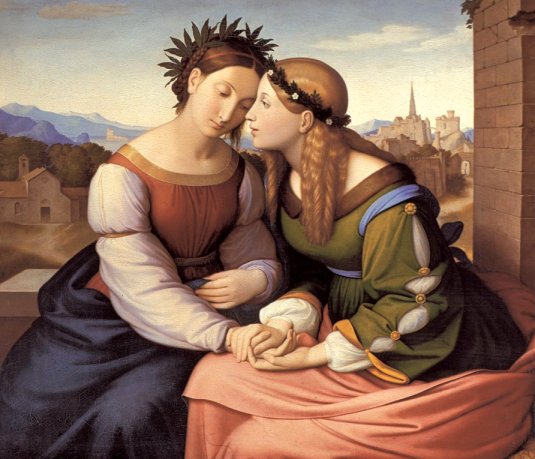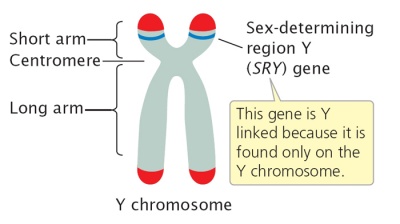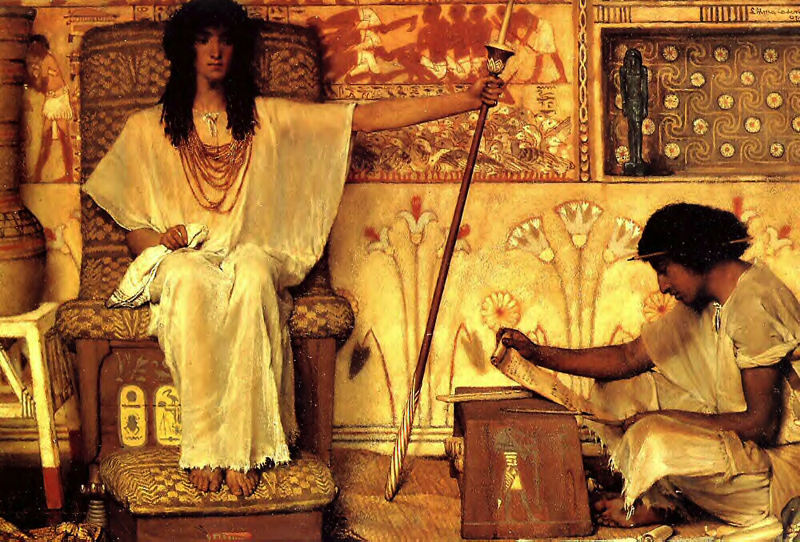And afterwards she bore a daughter, and called her name Dinah. (Genesis 30:21)
In my previous essay, “The Conflict Between Joseph And His Brothers—A Gender Theory,” I suggested that Joseph exhibited some proclivity to feminine behavior in his youth. This impression can be naturally inferred from the verses and supported by traditions in Kabbalah related to Isaac, Joseph, and Benjamin, as we discussed in that essay. To be sure, Joseph outgrew his feminine tendencies (perhaps assisted by the tough love shown to him by his brothers). He matured into a man who was not only a husband, a father, and the de facto ruler of Egypt, but an archetype of masculinity and a paradigm of piety, for which he earned the designation of Joseph, the Righteous (Yosef HaTzadik). Moreover, spiritually, Joseph personified Yesod of Zeer Anpin—the masculine aspect (Yesod) of the male principle (Zeer Anpin) in the divinity. However, what was the origin of Joseph’s childish femininity? There is a midrashic tradition that not only further bolsters our initial theses but gives it a whole new dimension.
According to the midrash,[1] when Leah became pregnant for the seventh time, she originally conceived a male child. She prophetically knew, however, that Jacob was destined to have twelve tribes. Jacob already sired six sons from her and four sons from the concubines, Zilpah and Bilhah. Leah was concerned that if she had another son, Rachel would have only one son—fewer than even concubines. Wishing to spare her sister from embarrassment, she prayed that the child is born female. Citing this midrash, Rashi comments: “Leah judged (din) herself, saying: ‘If this is a male, Rachel will not even be equal to the maidservants.’” According to the midrash, G‑d answered her prayer, and the gender of the fetus was changed to female in utero. As a result, Dinah was born.

Leah and Rachel
Rachel became pregnant with her first child approximately at the same time as Leah became pregnant for the seventh time. According to the midrash, Rachel conceived a girl. As a result of Leah’s prayers, Rachel’s fetus changed its gender to male, and Rachel gave birth to Joseph.
Before we address the scientific veracity of such gender change in utero, let us note that the midrash does not say that Leah prayed that Rachel gives birth to a male—Leah only prayed that she gives birth this time to a female. How did this affect Rachel’s fetus?
From the point of view of quantum mechanics, we can imagine a conceptual Hilbert space where the gender of a fetus is its quantum-mechanical state that has binary values—male or female. In quantum mechanics, such a space is called a spin space.[2] According to the rules of quantum mechanics, until observed, the fetus is in a superposition of both states—male and female.[3]

Entangled Sisters
It is logical to assume that the two fetuses—one carried by Leah and the other carried by Rachel—were entangled, that is, both fetuses represented one integral system.[4] There are two main reasons for this. First, both fetuses shared the same father. Second, their mothers, who were sisters,[5] were entangled.[6] Moreover, Leah specifically entangled her unborn child with Rachel’s when she prayed about the gender of her child only to spare Rachel from shame (if she were to give birth to a girl). Thus, these two fetuses (future siblings) were entangled.[7]
As an example we have often used in previous essays, consider two entangled electrons. Each electron has a spin, which is in a superposition of states spin-up and spin-down.[8] If we were to collapse the wave function of the first electron and find its spin in a state, say, spin-up, the wave function of the second electron collapses automatically and instantaneously, and the second electron assumes the opposition state of spin-down.
On a conceptual level, this is exactly what the midrash describes. Leah prayed that she gives birth to a girl, and her prayer was answered. She did not pray for a change of gender in the Rachel’s gender—this happened automatically—as soon as the gender of Leah’s fetus was changed to female, the gender of Rachel’s fetus was changed to male. The midrash provides us here with a beautiful metaphor of quantum superposition and quantum entanglement.
Let us now turn to biology and ask ourselves a simple question: other than by miracle, how is it possible for a gender of a child to be changed in utero after conception? Isn’t the gender decided at conception? Let us see what Talmud says about it.
The Talmud quotes a Mishnah stating, “If a man’s wife is pregnant and he says, May [G‑d] grant that my wife bear [son] etc., this is a prayer in vain.” The Gemara[9] discusses this Mishnah as follows:
R. Joseph cited the following in objection: And afterward, she bore a daughter and called her name Dinah. (Bereshit 30:21) What is meant by “afterward”? Rav said: After Leah had passed judgment on herself, saying, “Twelve tribes are destined to issue from Jacob. Six have issued from me and four from the handmaids, making ten. If this child will be a male, my sister Rachel will not be equal to one of the handmaids.” Forthwith the child was turned to a girl, as it says, “And she called her name Dinah”! — We cannot cite a miraculous event [in refutation of the Mishnah]. Alternatively, I may reply that the incident of Leah occurred within forty days [after conception][10]
The first part of this Gemara takes the same position as the midrash cited above. When the verse states, “And afterwards she bore a daughter, and called her name Dinah,” the Gemara interprets the word “afterwards” to mean after Leah’s prayer was accepted. The Gemara grapples with the question, How is it possible given the Mishnah that says praying for a gender of the child after the conception is the prayer in vain? The Gemara answers that during the first forty days, it is possible to pray for the gender of the child. Only after forty days, it is a prayer in vain.[11]
Now we are left with the question of how we can reconcile this Gemara with modern embryology. This was beautifully done in the paper, “On the Embryological Foresight of the Talmud,”[12] by my favorite author—my wife, Leah Poltorak. As she writes in that paper:
The chromosomal makeup of the fertilized egg: XX or XY is not the only factor determining the embryo’s gender. The successful expression of the SRY gene located on the short arm of the Y chromosome is another crucial factor. In fact, it takes approximately forty days from the time of conception for male gender to become irreversibly determined and about eighty days for female gender to be determined.

This analysis resolves the problem. With her prayer, Leah could have epigenetically suppressed the SRY gene expression affecting the gender formation of her fetus. And, because her fetus was entangled, as it were, with the fetus carried by Rachel, the gender of that fetus changes as well. As a result, Leah gave birth to Dinah and Rachel to Joseph. Presumably, on a spiritual level, this gender-swapping engendered the swapping of the souls as well. Joseph and Dinah, therefore, were not only siblings but soulmates.
Based on the midrash and the above analysis, it follows that Joseph was initially conceived as a girl and changed to a boy in utero. No wonder that, as a child, Joseph displayed feminine tendencies (e.g., touching up his eyes). It took some tough love of his brothers to make a man out of him.
There appears to be a parallel between the stories of Isaac and Rebecca, on the one hand, and Joseph and Dina, on the other. Whereas Isaac marries his soulmate, Rebecca, Joseph ultimately marries His soulmate’s (Dina’s) daughter, Asenath.[13] And just as Isaac’s marriage to Rebecca was not possible, but for the Akeida, so too, the marriage between Joseph and Asenath was not possible but for his brothers selling him to Egypt. This brings us full circle to our thesis of the previous essay, “The Conflict Between Joseph And His Brothers—A Gender Theory,” in which it was hypothesized that the brothers conspired to sell Joseph for his own benefit. The puzzle is now complete.
—————————————-
Endnotes:
[1] Targum pseudo-Jonathan on Genesis 30:21.
[2] Using Dirac bra ket notations, we can write that a male fetus has a state |male〉 and a female fetus has a state |female〉.
[3] In bra ket notations, the state of superposition is expressed as 1/√2|male〉 + 1/√2|female〉.
[4] In quantum mechanics, two entangles objects (such as particles) are described by the same wave function or the same state vector.
[5] Moreover, according to midrash Seder Olam Rabbah, Leah and Rachel were twin sisters.
[6] See my earlier essay, “The Entangled Sisters.”
[7] As always, this is not meant literally, but metaphorically.
[8] In bra ket notations, we can write that an electron is in a state of superposition 1/√2| spin-up〉 + 1/√2| spin-down 〉 or 1/√2|↑〉 + 1/√2|↓〉.
[9] Gemara is a commentary on Mishnah. Whereas Mishnah was composed by the earlier sages called Tannaim (pl of Tanna) in 1-2 c CE, the Gemara was composed by the later sages called Amoraim (pl. of Amora) in 2-5 c CE. Mishnah and Gemara together comprise Talmud. There are two versions of Gemara—Jerusalem Talmud (Talmud Yerushalmi) composed in land of Israel between c. 350-450 CE, and Babylonian Talmud (Talmud Bavli) composed in Babylonian exile and completed c. 500 CE. Traditionally, any reference to the Talmud or Gemara without further qualification refers to the Babylonian Talmud, which is the one that is primarily studied.
[10] Talmud, tr. Berachot 60a. The Rabbi Joseph reconciles his objection with the Mishnah by saying that this incident could have happened withing 40 days of Leah’s pregnancy. From this, the Gemara learns that one can pray for the gender of a child for the first 40 days of pregnancy.
[11] Interestingly, in the tractate Niddah 30b, Rabbi Ishmael says that it takes eighty days for an embryo to become completely formed as a female.
[12] Leah Poltorak, “On the Embryological Foresight of the Talmud,” B’Or Ha’Torah 19 (5770/2009), pp.19-24. (https://www.jct.ac.il/en/publications/bor-hatorah/b-or-ha-torah-19#acc7337_1, retrieved on December, 22, 2020).
[13] Midrash, Yalkut Shimoni 134.


Leave A Comment